基础代谢率影响能量代谢的因素
影响能量代谢的因素
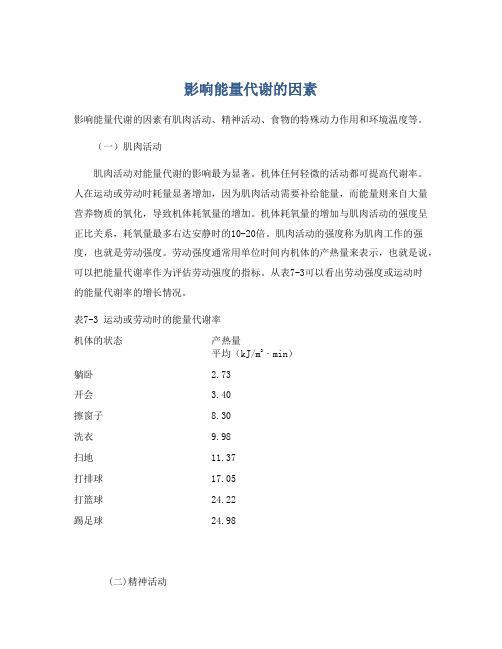
影响能量代谢的因素影响能量代谢的因素有肌肉活动、精神活动、食物的特殊动力作用和环境温度等。
(一)肌肉活动肌肉活动对能量代谢的影响最为显著。
机体任何轻微的活动都可提高代谢率。
人在运动或劳动时耗量显著增加,因为肌肉活动需要补给能量,而能量则来自大量营养物质的氧化,导致机体耗氧量的增加。
机体耗氧量的增加与肌肉活动的强度呈正比关系,耗氧量最多右达安静时的10-20倍。
肌肉活动的强度称为肌肉工作的强度,也就是劳动强度。
劳动强度通常用单位时间内机体的产热量来表示,也就是说,可以把能量代谢率作为评估劳动强度的指标。
从表7-3可以看出劳动强度或运动时的能量代谢率的增长情况。
表7-3 运动或劳动时的能量代谢率机体的状态产热量平均(kJ/m2・min)躺卧 2.73开会 3.40擦窗子8.30洗衣9.98扫地11.37打排球17.05打篮球24.22踢足球24.98(二)精神活动脑的重量只占体重的2%,但在安静状态下,却有15%左右的循环血量进入脑循环系统,这说明脑组织的代谢水平是很高的。
据测定。
在安静状态下,100g脑组织的耗氧量为3.5ml/min(氧化的葡萄糖量为4.5mg/min),此值接近安静肌肉组织耗氧量的20倍,脑组织的代谢率虽然如此之高,但据测定,在睡眠中和在活跃的精神活动情况下,脑中葡萄糖的代谢率却几乎没有差异。
可见,在精神活动中,中枢神经系统本身的代谢率即使有些增强,其程度也是可以忽略的。
人在平静地思考问题时,能量代谢受到的影响并不大,产热量增加一般不超过4%。
但在精神处于紧张状态,如烦恼、恐惧或强烈情绪激动时,由于随之出现的无意识的肌紧张以及刺激代谢的激素释放增多等原因,产热量可以显著增加。
因此,在测定基础代谢率时,受试者必须摒除精神紧张的影响。
(三)食物的特殊动力作用在安静状态下摄入食物后,人体释放的热量比摄入的食物本身氧化后所产生的热量要多。
例如摄入能产100kJ热量的蛋白质后,人体实际产热量为130kJ,额外多产生了30kJ热量,表明进食蛋白质后,机体产热量超过了蛋白质氧化后产热量的3 0%。
能量代谢的调节机制

能量代谢的调节机制能量代谢是指生物机体在代谢过程中释放能量的总和,涉及多个器官、组织和分子。
正常的能量代谢是必须的,但是能量代谢的异常会导致各种疾病的发生和发展。
因此,对能量代谢的调节机制的研究具有重要的理论和实践意义。
一、基础代谢率的调节人体基础代谢率指的是在安静状态下,保持一定条件的情况下,维持每日基本生命活动所需的最低能量消耗。
基础代谢率是人体代谢的基本指标之一,也是能量代谢的最基本过程之一。
许多因素可以影响基础代谢率。
其中最明显和最常见的因素是体重和身高。
性别和年龄也会影响基础代谢率的差异,其中女性和老年人的基础代谢率较低。
此外,环境温度对人体基础代谢率的影响也是不可忽视的。
当环境温度升高或降低时,人体需要消耗更多的能量来维持体温。
在寒冷的环境中,产热作用增强,生命活动的机体代谢强度增加,能量代谢率也随之升高。
在高温环境中,体内产热作用减少,身体的新陈代谢速度下降,能量代谢率也随之下降。
二、食物消化、吸收和利用的调节食物的消化、吸收和利用,是人体能量代谢的另一重要环节。
当我们吃某种食物时,其中的营养物质需要被消化吸收后才能被人体利用。
消化和吸收过程涉及到多种胃肠功能的正常运作,包括肠壁屏障和肠道蠕动等。
“营养转移”过程中,重要的激素包括胰岛素、胃液素和胰高血糖素等。
胰岛素分泌的时间和分泌量受到食物种类、数量和身体状态等因素的影响。
胃液素和胰高血糖素在食物进入十二指肠时也会被分泌。
营养物质进入细胞后,储存在体内,这被称为脂肪沉积。
脂肪沉积的过程也受到多种生理和环境因素的调节。
肥胖是脂肪积累过多的表现,肥胖主要是由于能量摄入超过能量消耗所致。
三、能量代谢的荷尔蒙调节人体内分泌系统的激素也可以调节能量代谢。
甲状腺激素是体内代谢的重要激素之一,其含量可以影响体内氧气的消耗速率。
它在体内的水平受到体内的营养状态、补充物的摄入、温度、疾病和一些药物的影响。
胰岛素是体内葡萄糖代谢的另一个关键激素。
它能够促进细胞摄取和利用葡萄糖,还可以促使脂肪和蛋白质在分解后转化成葡萄糖,增加身体的能量储备。
基础代谢率名词解释及其应用

基础代谢率名词解释及其应用基础代谢率(Basal Metabolic Rate,BMR)是指人体在清醒而又极端安静的状态下,不受肌肉活动、环境温度、食物及精神紧张等影响时的能量代谢率。
它反映了人体维持生命所需的最低能量消耗,与年龄、性别、身高、体重、体表面积、甲状腺功能等因素有关。
测定基础代谢率的方法有直接测热法、间接测热法和公式推测法,其中间接测热法是目前最常用的一种方法。
基础代谢率的测定对于评估人群的营养需要量、诊断甲状腺疾病、制定合理的膳食计划等方面有重要意义。
一、基础代谢率的定义基础代谢率(Basal Metabolic Rate,BMR)是指人体在清醒而又极端安静的状态下,不受肌肉活动、环境温度、食物及精神紧张等影响时的能量代谢率。
也就是说,当人处于这种状态时,每小时每平方米体表所散发的热量千焦数就是基础代谢率,其单位为kJ/(m2⋅h)。
基础代谢率反映了人体维持生命各器官进行最基本的生理机能所消耗的热能需要量,如维持心跳、呼吸、血液循环、神经传导、细胞分裂等。
它占据了人体每日总能量消耗的60%~75%,因此是人体能量平衡的重要组成部分。
二、基础代谢率的测量方法测定基础代谢率的方法有三种:直接测热法、间接测热法和公式推测法。
2.1 直接测热法直接测热法是将被测者置于一特殊的检测环境中,收集被测者在一定时间内(通过辐射、传导、对流及蒸发四个方面)发散的总热量,然后换算成单位时间的代谢量,即能量代谢率。
这种方法可以直接反映人体产生和散发热量之间的平衡关系,但是其装置较为复杂,操作困难,费用高昂,不适合大规模应用。
2.2 间接测热法间接测热法是根据三大产能营养素(碳水化合物、脂肪和蛋白质)在产能时所消耗的氧气和产生的二氧化碳间存在的定比关系,在特定条件下、一定时间内通过测量耗氧量和二氧化碳生成量来计算能量消耗。
这种方法的原理是基于能量守恒定律,即机体消耗的能量应等于产生的热能和所做的外功之和。
饲养动物的能量需求与能量代谢
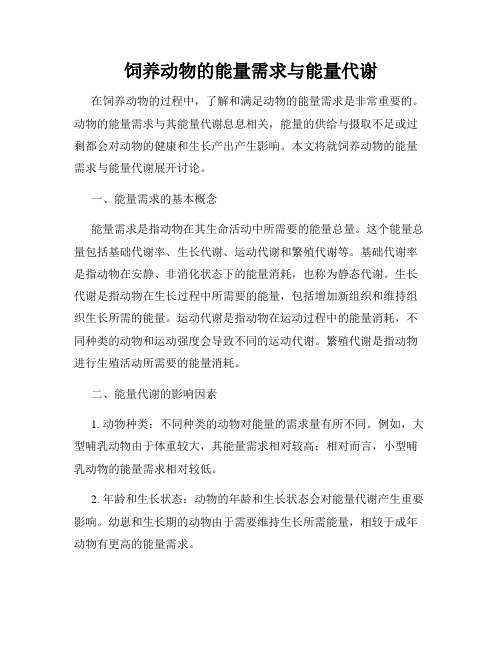
饲养动物的能量需求与能量代谢在饲养动物的过程中,了解和满足动物的能量需求是非常重要的。
动物的能量需求与其能量代谢息息相关,能量的供给与摄取不足或过剩都会对动物的健康和生长产出产生影响。
本文将就饲养动物的能量需求与能量代谢展开讨论。
一、能量需求的基本概念能量需求是指动物在其生命活动中所需要的能量总量。
这个能量总量包括基础代谢率、生长代谢、运动代谢和繁殖代谢等。
基础代谢率是指动物在安静、非消化状态下的能量消耗,也称为静态代谢。
生长代谢是指动物在生长过程中所需要的能量,包括增加新组织和维持组织生长所需的能量。
运动代谢是指动物在运动过程中的能量消耗,不同种类的动物和运动强度会导致不同的运动代谢。
繁殖代谢是指动物进行生殖活动所需要的能量消耗。
二、能量代谢的影响因素1. 动物种类:不同种类的动物对能量的需求量有所不同。
例如,大型哺乳动物由于体重较大,其能量需求相对较高;相对而言,小型哺乳动物的能量需求相对较低。
2. 年龄和生长状态:动物的年龄和生长状态会对能量代谢产生重要影响。
幼崽和生长期的动物由于需要维持生长所需能量,相较于成年动物有更高的能量需求。
3. 环境温度:环境温度对动物的能量需求具有显著影响。
较低的环境温度会导致动物的体温降低,从而增加其能量消耗以维持体温正常。
4. 生理状态:怀孕、哺乳等生理状态会增加动物的能量需求。
三、饲料能量的评价和供给了解饲料的能量评价和供给对确保动物的能量需求至关重要。
通常使用的饲料能量评价方法有槽样法、代谢能法和直接测定法。
槽样法是指通过测量饲料在动物消化道中的消化情况,评估其能量含量。
代谢能法是通过测量动物在特定条件下的能量平衡来评估饲料的能量价值。
直接测定法是通过实验室分析技术直接测定饲料中的能量含量。
根据动物的能量需求,合理供给饲料能量对于饲养效果和生产效益的提升至关重要。
在实际饲养中,可以通过日粮的能量平衡来实现饲料能量的供给。
日粮的能量平衡可以通过计算日粮能量的摄入和消耗来实现。
能量代谢

般男性高于女性、幼年高于成人、老年低于 成人。 基础代谢率受体温的影响,体温升高1℃, 基础代谢率升高13%。 基础代谢率的测定值与正常值相差±10%15%之内,均属正常,相差超过20%属病理 情况。过度训练可引起基础代谢率升高。
二、能量代谢的测定原理
第二章
能量代谢
针灸系康复医学教研室
第一节 概述
一、基础代谢的概念 基础代谢:指基础状态下的能量代谢。所谓 基础状态是指人体处在清醒、安静、空腹、 室温在20-25º C条件下。 基础代谢率:指单位时间内的基础代谢。
体表面积(m2)=0.0061×身长+0.0128×体
重-0.1529
每消耗1升氧所产生的热量称为该物质的氧 热价。 糖:2lKJ 脂肪:19.7KJ
蛋白质:18.8KJ
(二)呼吸商
呼吸商(respiratory quotient,RQ):各种物
质在体内氧化时所产生的二氧化碳与所消耗 的氧的容积之比。 葡萄糖:l 脂肪:约为0.71 蛋白质:约为0.80
一般情况下,人类摄取的食物为混合食物,
(三)健身运动的能量供应
运动强度<50%VO2max时:脂肪氧化分解成为
主要能源,血浆中游离脂肪酸的浓度每两分 钟就更新50%,说明脂肪代谢非常活跃。
运动强度>50%VO2max时:糖的分解供能显著
加强。
健身运动的强度:50%-70%VO2max 理想的运动时间:30分钟-1小时
(三)ATP的贮备及输出功率
肌肉ATP含量:6mmol/kg湿肌
最大输出功率:11.2mmolATP/kg/s
启动极为迅速。
但由于ATP贮量有限,运动中ATP消耗
动物能量代谢指标
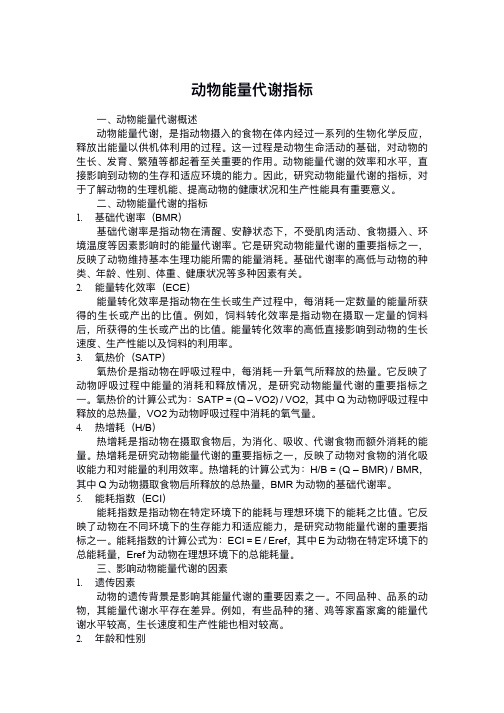
动物能量代谢指标⼀、动物能量代谢概述动物能量代谢,是指动物摄⼊的⻝物在体内经过⼀系列的⽣物化学反应,释放出能量以供机体利⽤的过程。
这⼀过程是动物⽣命活动的基础,对动物的⽣⻓、发育、繁殖等都起着⾄关重要的作⽤。
动物能量代谢的效率和⽔平,直接影响到动物的⽣存和适应环境的能⼒。
因此,研究动物能量代谢的指标,对于了解动物的⽣理机能、提⾼动物的健康状况和⽣产性能具有重要意义。
⼆、动物能量代谢的指标1.基础代谢率(BMR)基础代谢率是指动物在清醒、安静状态下,不受肌⾁活动、⻝物摄⼊、环境温度等因素影响时的能量代谢率。
它是研究动物能量代谢的重要指标之⼀,反映了动物维持基本⽣理功能所需的能量消耗。
基础代谢率的⾼低与动物的种类、年龄、性别、体重、健康状况等多种因素有关。
2.能量转化效率(ECE)能量转化效率是指动物在⽣⻓或⽣产过程中,每消耗⼀定数量的能量所获得的⽣⻓或产出的⽐值。
例如,饲料转化效率是指动物在摄取⼀定量的饲料后,所获得的⽣⻓或产出的⽐值。
能量转化效率的⾼低直接影响到动物的⽣⻓速度、⽣产性能以及饲料的利⽤率。
3.氧热价(SATP)氧热价是指动物在呼吸过程中,每消耗⼀升氧⽓所释放的热量。
它反映了动物呼吸过程中能量的消耗和释放情况,是研究动物能量代谢的重要指标之⼀。
氧热价的计算公式为:SATP=(Q–VO2)/VO2,其中Q为动物呼吸过程中释放的总热量,VO2为动物呼吸过程中消耗的氧⽓量。
4.热增耗(H/B)热增耗是指动物在摄取⻝物后,为消化、吸收、代谢⻝物⽽额外消耗的能量。
热增耗是研究动物能量代谢的重要指标之⼀,反映了动物对⻝物的消化吸收能⼒和对能量的利⽤效率。
热增耗的计算公式为:H/B=(Q–BMR)/BMR,其中Q为动物摄取⻝物后所释放的总热量,BMR为动物的基础代谢率。
5.能耗指数(ECI)能耗指数是指动物在特定环境下的能耗与理想环境下的能耗之⽐值。
它反映了动物在不同环境下的⽣存能⼒和适应能⼒,是研究动物能量代谢的重要指标之⼀。
临床执业医师考试真题解析生理学第六单元能量代谢和体温
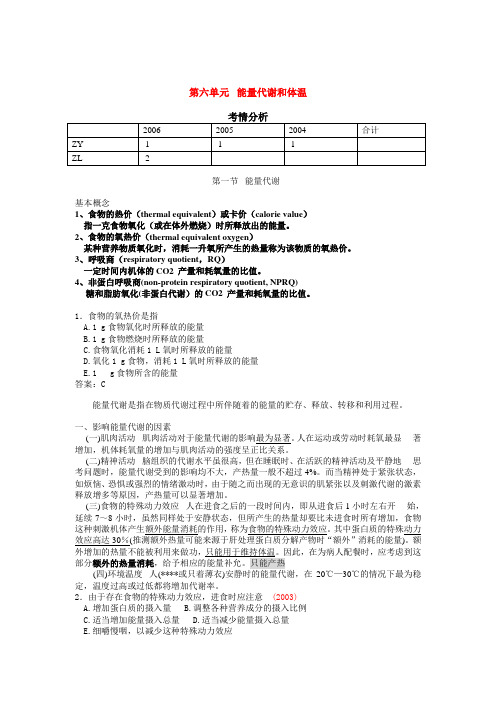
第六单元能量代谢和体温考情分析2006 2005 2004 合计ZY 1 1 1ZL 2第一节能量代谢基本概念1、食物的热价(thermal equivalent)或卡价(calorie value)指一克食物氧化(或在体外燃烧)时所释放出的能量。
2、食物的氧热价(thermal equivalent oxygen)某种营养物质氧化时,消耗一升氧所产生的热量称为该物质的氧热价。
3、呼吸商(respiratory quotient,RQ)一定时间内机体的CO2 产量和耗氧量的比值。
4、非蛋白呼吸商(non-protein respiratory quotient, NPRQ)糖和脂肪氧化(非蛋白代谢)的CO2 产量和耗氧量的比值。
1.食物的氧热价是指A.1 g食物氧化时所释放的能量B.1 g食物燃烧时所释放的能量C.食物氧化消耗1 L氧时所释放的能量D.氧化1 g食物,消耗1 L氧时所释放的能量E.1 g食物所含的能量答案:C能量代谢是指在物质代谢过程中所伴随着的能量的贮存、释放、转移和利用过程。
一、影响能量代谢的因素(一)肌肉活动肌肉活动对于能量代谢的影响最为显著。
人在运动或劳动时耗氧最显著增加,机体耗氧量的增加与肌肉活动的强度呈正比关系。
(二)精神活动脑组织的代谢水平虽很高,但在睡眠时、在活跃的精神活动及平静地思考问题时,能量代谢受到的影响均不大,产热量一般不超过4%。
而当精神处于紧张状态,如烦恼、恐惧或强烈的情绪激动时,由于随之而出现的无意识的肌紧张以及刺激代谢的激素释放增多等原因,产热量可以显著增加。
(三)食物的特殊动力效应人在进食之后的一段时间内,即从进食后1小时左右开始,延续7~8小时,虽然同样处于安静状态,但所产生的热量却要比未进食时所有增加,食物这种刺激机体产生额外能量消耗的作用,称为食物的特殊动力效应。
其中蛋白质的特殊动力效应高达30%(推测额外热量可能来源于肝处理蛋白质分解产物时“额外”消耗的能量)。
什么是基础代谢率

什么是基础代谢率?基础代谢,(白菜妹官方解释)是指人体在清醒又极端安静状态下(不吃、不喝、不动、不思考)的能量代谢率,其变化跟个人肌肉含量、代谢状态等有关系。
简单点说,就是一天啥也不干静静地躺在床上消耗的热量。
是的,即使你不运动,静静的躺在床上也能消耗热量。
在一天的热量消耗中,基础代谢消耗的热量是大头,能占到60%-70%,可见基础代谢率对减肥非常重要。
有些姑娘明明吃的很少可体重还不见下降,就如她说的日常吃的很少又不吃零食,此时可以推断下她的基础代谢不好。
影响基础代谢率的因素有哪些?影响基础代谢的因素大致可以分为3种:年龄、性别、饮食、情绪、温度、瘦体重、运动等。
年龄、性别咱们无法改变,能改变的就是饮食、喝水、温度、瘦体重、运动等。
如何提高基础代谢?1、多吃点蛋白质想要更好减肥,蛋白质少不了,蛋白质属于大分子,足够的蛋白质能促使肌体每天多燃烧150——200卡路里的热量。
当然不是越多越好,也是有量的控制;成人每天的蛋白质需要约65g-80g,分量大概是:一个水煮蛋+一杯牛奶+一个网球大小的瘦肉。
蛋白质优先鱼类、牛肉、蛋类、奶制品、豆制品等优质蛋白。
2、增加肌肉含量1 kg 的脂肪只能消耗4~10 卡的热量,但1 kg 的肌肉却能消耗75-125卡,同一质量下肌肉消耗的热量是脂肪的整整十几倍。
哑铃、俯卧撑等阻力运动有助增加肌肉,但一定要坚持;多活动,没事的时候多走走,走路的时候比平时快点,这样消耗的热量也多;办公室坐着,每隔半个小时站起来活动活动;坐着的时候,抖动抖动腿,都有助于热量的消耗。
3、多喝水水参与身体的代谢,能够提高代谢,饭前来一杯,能够增加饱腹感,减少进食,意味着减少摄入热量。
4、泡澡冬季天冷可以经常泡澡,高温度对提高代谢有帮助。
注意,基础代谢提高了,也不意味着可以随便吃,不运动就可以不长胖了,维系一个稳定的基础代谢需要长期时间。
基础代谢+消耗
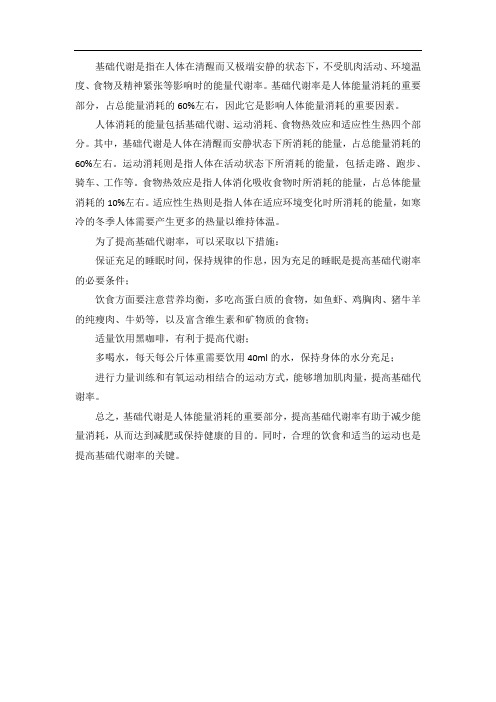
基础代谢是指在人体在清醒而又极端安静的状态下,不受肌肉活动、环境温度、食物及精神紧张等影响时的能量代谢率。
基础代谢率是人体能量消耗的重要部分,占总能量消耗的60%左右,因此它是影响人体能量消耗的重要因素。
人体消耗的能量包括基础代谢、运动消耗、食物热效应和适应性生热四个部分。
其中,基础代谢是人体在清醒而安静状态下所消耗的能量,占总能量消耗的60%左右。
运动消耗则是指人体在活动状态下所消耗的能量,包括走路、跑步、骑车、工作等。
食物热效应是指人体消化吸收食物时所消耗的能量,占总体能量消耗的10%左右。
适应性生热则是指人体在适应环境变化时所消耗的能量,如寒冷的冬季人体需要产生更多的热量以维持体温。
为了提高基础代谢率,可以采取以下措施:
保证充足的睡眠时间,保持规律的作息,因为充足的睡眠是提高基础代谢率的必要条件;
饮食方面要注意营养均衡,多吃高蛋白质的食物,如鱼虾、鸡胸肉、猪牛羊的纯瘦肉、牛奶等,以及富含维生素和矿物质的食物;
适量饮用黑咖啡,有利于提高代谢;
多喝水,每天每公斤体重需要饮用40ml的水,保持身体的水分充足;
进行力量训练和有氧运动相结合的运动方式,能够增加肌肉量,提高基础代谢率。
总之,基础代谢是人体能量消耗的重要部分,提高基础代谢率有助于减少能量消耗,从而达到减肥或保持健康的目的。
同时,合理的饮食和适当的运动也是提高基础代谢率的关键。
能量代谢基础代谢率和热效应

能量代谢基础代谢率和热效应能量代谢是指人体内各种代谢反应所释放的能量。
而能量代谢的两个重要指标是基础代谢率(BMR)和热效应(TEF)。
本文将就基础代谢率和热效应的概念、作用、影响因素以及调节方法进行探讨。
一、基础代谢率基础代谢率是指人体在静息状态下,保持生命活动所需的最低能量消耗。
它包括了呼吸、心跳、体温调节等基本生命活动所需的能量。
基础代谢率占整个能量代谢的70%左右,是人体能量消耗的主要来源。
基础代谢率的计算公式为:BMR = 体重(kg)× 24(小时)×男性0.9 或女性 0.7(单位:大卡/天)。
其中,性别、年龄、体重和身高是影响基础代谢率的重要因素。
影响基础代谢率的因素有:1. 性别:男性基础代谢率较女性高,这是因为男性骨骼肌密度和体脂肪含量相对较高。
2. 年龄:随着年龄的增长,基础代谢率会逐渐降低,主要是因为肌肉组织减少和体脂肪含量增加。
3. 体重和身高:体重和身高越高,基础代谢率也会相应增加。
调节基础代谢率可以通过以下方法:1. 运动:适当的有氧运动可以提高基础代谢率,例如慢跑、游泳等。
2. 饮食:多摄入富含蛋白质的食物,因为蛋白质的消化和吸收需要较多的能量,可以增加基础代谢率。
3. 增加肌肉:增加肌肉的比例可以增加基础代谢率,因为肌肉组织的能量消耗比脂肪组织更高。
二、热效应热效应是指消化、吸收和代谢食物所需的能量。
食物的热效应分为三个部分:食物消化过程中的机械能消耗(由咀嚼、吞咽等过程产生)、化学能消耗(由食物消化和吸收过程产生)以及新陈代谢过程中的能量消耗。
热效应的计算公式为:TEF = 摄入能量(大卡)× 10%。
热效应通常占整个能量代谢的10%左右。
影响热效应的因素有:1. 食物类型:蛋白质的热效应最高,约为20-30%;碳水化合物的热效应约为5-10%;脂肪的热效应最低,约为0-3%。
2. 食物摄入量:摄入较大量的食物,热效应相对较高。
3. 饮食频率:多次少量的进食可以增加热效应。
基础代谢率名词解释

基础代谢率名词解释基础代谢率(Basal Metabolic Rate,缩写为BMR)是指人体在安静、完全清醒状态下,为维持基本生命活动(例如心跳、呼吸、细胞合成等)所需的最低能量消耗。
基础代谢率是一个人体能量代谢的重要指标,它不受食物摄入、体力活动和环境温度等因素的影响,而主要受到个体的体重、年龄、性别和体组成等因素的影响。
通常情况下,基础代谢率占到人体总能量消耗的60-70%。
体重对基础代谢率的影响主要是因为体重增加,需要更多的能量来维持身体的正常运转。
所以,一般来说,体重较重的人基础代谢率较高,而体重较轻的人基础代谢率较低。
年龄对基础代谢率的影响主要是因为随着年龄的增长,肌肉组织逐渐减少,而脂肪组织逐渐增多,从而导致基础代谢率的降低。
因此,年龄较大的人基础代谢率较低,而年龄较小的人基础代谢率较高。
性别对基础代谢率的影响主要是因为男性相对于女性来说,体重更大、肌肉组织更多,因此,男性的基础代谢率一般高于女性。
体组成对基础代谢率的影响主要是因为肌肉组织相对于脂肪组织来说,代谢率更高。
所以,相同体重下,肌肉组织较多的人基础代谢率较高,而脂肪组织较多的人基础代谢率较低。
通过了解自己的基础代谢率,可以帮助人们更好地管理自己的体重和调节饮食。
例如,如果一个人想要减肥,可以通过限制能量摄入来达到减肥的目的。
而了解自己的基础代谢率,可以帮助人们计算出每天所需的最低能量摄入,从而更科学地减肥。
总之,基础代谢率是指人体在安静、完全清醒状态下,为维持基本生命活动所需的最低能量消耗。
它受到体重、年龄、性别和体组成等因素的影响。
通过了解自己的基础代谢率,可以帮助人们更好地管理体重和调节饮食。
人体能量代谢的基础知识及因素影响
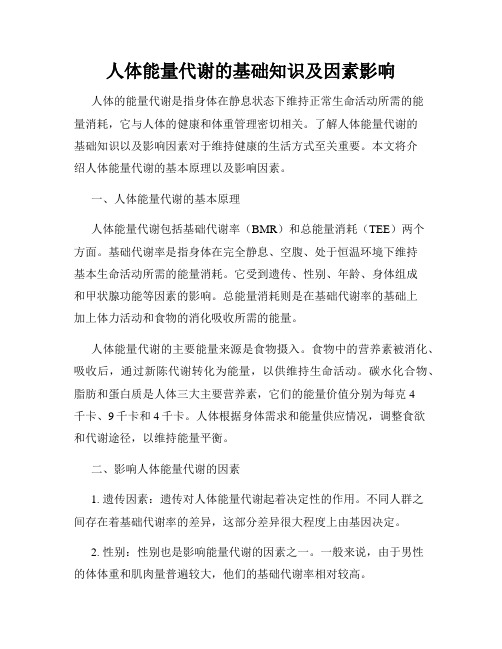
人体能量代谢的基础知识及因素影响人体的能量代谢是指身体在静息状态下维持正常生命活动所需的能量消耗,它与人体的健康和体重管理密切相关。
了解人体能量代谢的基础知识以及影响因素对于维持健康的生活方式至关重要。
本文将介绍人体能量代谢的基本原理以及影响因素。
一、人体能量代谢的基本原理人体能量代谢包括基础代谢率(BMR)和总能量消耗(TEE)两个方面。
基础代谢率是指身体在完全静息、空腹、处于恒温环境下维持基本生命活动所需的能量消耗。
它受到遗传、性别、年龄、身体组成和甲状腺功能等因素的影响。
总能量消耗则是在基础代谢率的基础上加上体力活动和食物的消化吸收所需的能量。
人体能量代谢的主要能量来源是食物摄入。
食物中的营养素被消化、吸收后,通过新陈代谢转化为能量,以供维持生命活动。
碳水化合物、脂肪和蛋白质是人体三大主要营养素,它们的能量价值分别为每克4千卡、9千卡和4千卡。
人体根据身体需求和能量供应情况,调整食欲和代谢途径,以维持能量平衡。
二、影响人体能量代谢的因素1. 遗传因素:遗传对人体能量代谢起着决定性的作用。
不同人群之间存在着基础代谢率的差异,这部分差异很大程度上由基因决定。
2. 性别:性别也是影响能量代谢的因素之一。
一般来说,由于男性的体体重和肌肉量普遍较大,他们的基础代谢率相对较高。
3. 年龄:随着年龄的增长,人体的基础代谢率逐渐降低。
这是因为随着年龄的增长,肌肉量减少、脂肪含量增加,导致能量消耗的下降。
4. 身体组成:人体的体脂肪含量和肌肉量对能量代谢有直接影响。
肌肉组织比脂肪组织消耗更多的能量,所以肌肉越发达,基础代谢率就越高。
5. 甲状腺功能:甲状腺素是调节人体代谢速率的重要激素。
甲状腺功能亢进或减退会影响基础代谢率,从而改变能量代谢的速率。
除了上述因素外,医药科学研究表明,环境温度、药物使用、季节、身体活动水平等均对人体能量代谢产生影响。
总结:人体能量代谢是人体维持生命活动所需的能量消耗。
基础代谢率和总能量消耗是能量代谢的两个方面。
基础代谢率
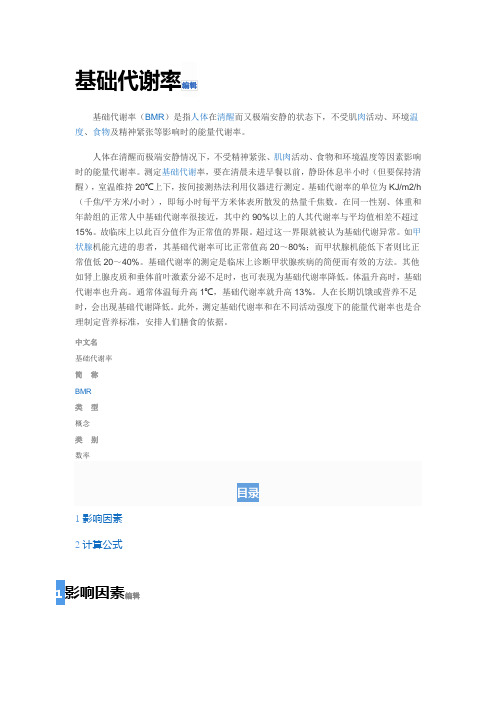
基础代谢率编辑基础代谢率(BMR)是指人体在清醒而又极端安静的状态下,不受肌肉活动、环境温度、食物及精神紧张等影响时的能量代谢率。
人体在清醒而极端安静情况下,不受精神紧张、肌肉活动、食物和环境温度等因素影响时的能量代谢率。
测定基础代谢率,要在清晨未进早餐以前,静卧休息半小时(但要保持清醒),室温维持20℃上下,按间接测热法利用仪器进行测定。
基础代谢率的单位为KJ/m2/h (千焦/平方米/小时),即每小时每平方米体表所散发的热量千焦数。
在同一性别、体重和年龄组的正常人中基础代谢率很接近,其中约90%以上的人其代谢率与平均值相差不超过15%。
故临床上以此百分值作为正常值的界限。
超过这一界限就被认为基础代谢异常。
如甲状腺机能亢进的患者,其基础代谢率可比正常值高20~80%;而甲状腺机能低下者则比正常值低20~40%。
基础代谢率的测定是临床上诊断甲状腺疾病的简便而有效的方法。
其他如肾上腺皮质和垂体前叶激素分泌不足时,也可表现为基础代谢率降低。
体温升高时,基础代谢率也升高。
通常体温每升高1℃,基础代谢率就升高13%。
人在长期饥饿或营养不足时,会出现基础代谢降低。
此外,测定基础代谢率和在不同活动强度下的能量代谢率也是合理制定营养标准,安排人们膳食的依据。
中文名基础代谢率简称BMR类型概念类别数率1影响因素2计算公式1影响因素编辑(1)体表面积身材大小不同,人体的基础代谢总量的显然不同,基础代谢与人体的体表面积呈比例关系。
Rubner早在1894年发现,基础代谢率如果以单位体表面积表示,则比较恒定。
人体的体表面积与体重及身高显著相关。
三十年代,Stevensen曾经得出我国人体表面积的计算公式。
新中国成立以来。
国人身材有很大变化,身高、体重都明显增加。
赵松山等人于1983年对我国人体表面与身高、体重的关系进行了研究,得出我国成年人的体表面积可以按下式计算:性别与基础代谢率A=0.00659H+0.0126W-0.1603A:体表面积(m的平方)H:身高(cm)W:体重(kg)[1]我国营养学会根据近期的调查,1981年提出我国18~40岁的成年男性平均身高为170cm,体重为69kg,女性平均身高为160cm,体重为53kg。
201607生理学知识点及历年考研真题解析之能量代谢和体温

第七章能量代谢和体温考查内容:1.食物的能量转化。
食物的热价、氧热价和呼吸商。
能量代谢的测定原理和临床的简化测定方法。
影响能量代谢的因素,基础代谢和基础代谢率及其意义。
2.体温及其正常变动。
机体的产热和散热。
体温调节。
知识点1:机体能量的来源与利用一、可利用的能量形式:ATP(直接供能物质);磷酸肌酸(ATP的储存库)A型题1.(1992)关于ATP在能量代谢中的作用,哪项是错误的:A 体内合成反应所需的能量均由ATP直接供给B 能量的生成、贮存、释放和利用都以ATP为中心C ATP的化学能可转变为机械能、渗透能、电能以及热能等D ATP通过对氧化磷酸化作用调节其生成E 体内ATP的含量绝少而转换极快答案:A 层次:记忆考点:ATP解析:体内合成代谢所需的能量不是全部由ATP直接供给,例如GTP参与DNA 的复制和转录、UTP参与糖原合成、CTP参与神经细胞脑磷脂和核酸的合成。
2.(1993,1994)人体活动主要的直接供能物质是:A 葡萄糖B 脂肪酸C 磷酸肌酸D GTPE ATP答案:E 层次:记忆考点:ATP解析:ATP是体内活动主要的直接供能物质。
二、能量来源:糖(70%);脂肪(30%);蛋白质A型题3.(1995)静息状态时,体内耗糖量最多的器官是:A 肝B 心C 脑D 骨骼肌E 红细胞答案:C 层次:记忆考点:脑的能量来源解析:脑的能量供应主要依赖于糖的氧化分解,是静息状态下消耗糖最多的器官。
三、能量利用:热能(最低形式的能量);机械能A型题4.(2005)机体各种功能活动所消耗的能量中,最终不能转化为体热的是:A 心脏泵血并推动血液流动B 细胞合成各种功能蛋白质C 兴奋在神经纤维上传导D 肌肉收缩对外界物体做功E 内、外分泌腺体的分泌活动答案:D 层次:记忆考点:能量的转换形式解析:总的来说,体内各种功能活动消耗的能量主要转化为热能,只有肌肉收缩消耗能量可以转化为机械能而非热能。
中国营养学会 基础代谢计算公式
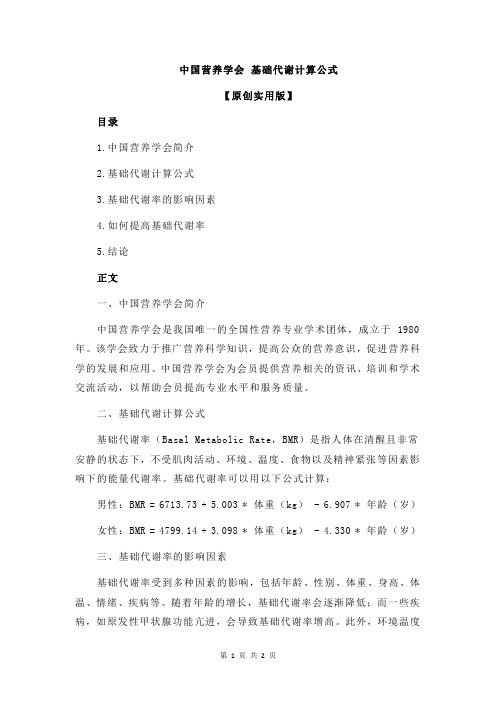
中国营养学会基础代谢计算公式【原创实用版】目录1.中国营养学会简介2.基础代谢计算公式3.基础代谢率的影响因素4.如何提高基础代谢率5.结论正文一、中国营养学会简介中国营养学会是我国唯一的全国性营养专业学术团体,成立于 1980 年。
该学会致力于推广营养科学知识,提高公众的营养意识,促进营养科学的发展和应用。
中国营养学会为会员提供营养相关的资讯、培训和学术交流活动,以帮助会员提高专业水平和服务质量。
二、基础代谢计算公式基础代谢率(Basal Metabolic Rate,BMR)是指人体在清醒且非常安静的状态下,不受肌肉活动、环境、温度、食物以及精神紧张等因素影响下的能量代谢率。
基础代谢率可以用以下公式计算:男性:BMR = 6713.73 + 5.003 * 体重(kg) - 6.907 * 年龄(岁)女性:BMR = 4799.14 + 3.098 * 体重(kg) - 4.330 * 年龄(岁)三、基础代谢率的影响因素基础代谢率受到多种因素的影响,包括年龄、性别、体重、身高、体温、情绪、疾病等。
随着年龄的增长,基础代谢率会逐渐降低;而一些疾病,如原发性甲状腺功能亢进,会导致基础代谢率增高。
此外,环境温度也会影响基础代谢率,温度越高,基础代谢率越高。
四、如何提高基础代谢率提高基础代谢率有助于减肥和保持健康。
以下是一些提高基础代谢率的方法:1.坚持锻炼:增加肌肉量是提高基础代谢率的关键。
有氧运动和力量训练都可以帮助增加肌肉量,从而提高基础代谢率。
2.多喝水:充足的水分摄入有助于提高新陈代谢速度,从而增加基础代谢率。
3.合理膳食:保证摄入充足的蛋白质、脂肪和碳水化合物,以满足身体对能量的需求。
同时,合理膳食可以避免营养过剩或不足,有利于保持健康的体重。
4.保持良好的情绪:情绪对基础代谢率也有影响。
长期的精神压力和负面情绪会导致基础代谢率降低。
保持良好的情绪和心态,有助于提高基础代谢率。
五、结论基础代谢率是反映人体能量消耗的重要指标,受到多种因素的影响。
基础代谢率例子
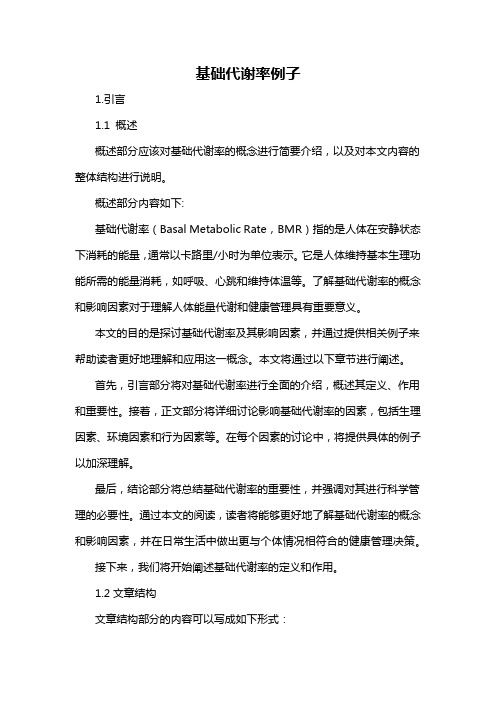
基础代谢率例子1.引言1.1 概述概述部分应该对基础代谢率的概念进行简要介绍,以及对本文内容的整体结构进行说明。
概述部分内容如下:基础代谢率(Basal Metabolic Rate,BMR)指的是人体在安静状态下消耗的能量,通常以卡路里/小时为单位表示。
它是人体维持基本生理功能所需的能量消耗,如呼吸、心跳和维持体温等。
了解基础代谢率的概念和影响因素对于理解人体能量代谢和健康管理具有重要意义。
本文的目的是探讨基础代谢率及其影响因素,并通过提供相关例子来帮助读者更好地理解和应用这一概念。
本文将通过以下章节进行阐述。
首先,引言部分将对基础代谢率进行全面的介绍,概述其定义、作用和重要性。
接着,正文部分将详细讨论影响基础代谢率的因素,包括生理因素、环境因素和行为因素等。
在每个因素的讨论中,将提供具体的例子以加深理解。
最后,结论部分将总结基础代谢率的重要性,并强调对其进行科学管理的必要性。
通过本文的阅读,读者将能够更好地了解基础代谢率的概念和影响因素,并在日常生活中做出更与个体情况相符合的健康管理决策。
接下来,我们将开始阐述基础代谢率的定义和作用。
1.2文章结构文章结构部分的内容可以写成如下形式:1.2 文章结构本文主要分为引言、正文和结论三大部分。
引言部分将概述基础代谢率的概念以及其在人体中的重要性。
同时介绍文章的结构以及整体目的,为读者提供对后续内容的预期。
正文部分将详细探讨基础代谢率的定义和作用,包括基础代谢率的基本概念和计算方法。
同时,将介绍影响基础代谢率的因素,如年龄、性别、体质指数、体成分等。
通过对这些因素的深入分析,读者将更好地了解基础代谢率的形成与变化机制。
结论部分将强调基础代谢率在人体健康和体重管理中的重要性,并总结本文的主要观点和结论。
通过对基础代谢率的研究和了解,读者可以更好地掌握自身的基础代谢率水平,并采取适当的措施来合理控制体重和保持健康。
整篇文章将以逻辑性和条理性为主线,通过概念介绍、因素分析和结论总结,全面探讨基础代谢率的例子及其重要性,旨在为读者提供对基础代谢率的全面认识和理解。
模块24-能量代谢与基础代谢率

国家开放大学人体生理学课程教学团队
建议学习时间20分钟
引言
人体进行各种生命活动都需要一定的能量, 人体所利用的能量是食物中蕴藏的化学能。 食物中的能量是如何在机体中转化、利用的? 影响能量代谢的因素有哪些?能量代谢的测 定以及基础代谢率的测定与临床工作有哪些 关系?这是本模块试图解决的问题。
目录
CONTENTS
1 学习目标 2 学习内容 3 小结
学习目标
1.复述能量代谢的概念 2.说明影响能量代谢的因素 3.复述基础代谢率的概念,说出测定基础代谢率的条件(基础状态) 4.说出基础代谢率正常值及其临床意义
学习内容
一
能量代谢和能量 代谢率
能量来源、利用 能量代谢率
二
影响能量代谢 的因素
肺量计结构模式图
学习内容
临床联系: 糖、脂肪、蛋白质三种营养物质,经消化转变成为可吸收的小分子营养 物质而被吸收入血。合成代谢和分解代谢是物质代谢过程中互相联系的、 不可分割的两个侧面。如果摄入太多,身体需要不了那么多营养,就把它 变成脂肪积存起来,要使自己不发胖,必须保持做到:每天摄取的热量 =身体消耗的热量.要使自己减肥,就必须做到:每天消耗的热量>摄取 的热量。这就是减肥的原理。要体重控制,就必须管理好自己的体重, 通过饮食的调节,生活习惯的改变,合理的运动,达到健康体重的目的, 这些也是体重控制成功的关键。运动方面主要通过适合各自情况个性化 制定出来的运动计划,并按部就班执行,运动要求切实可行;饮食的控 制,饮食的控制不是绝食,实际上是了解自己一天应该获得多少热量, 然后合理安排饮食,以获得一个均衡的营养摄入。
23
Q &A
提问:解释基础代谢和基础代谢率。
- 1、下载文档前请自行甄别文档内容的完整性,平台不提供额外的编辑、内容补充、找答案等附加服务。
- 2、"仅部分预览"的文档,不可在线预览部分如存在完整性等问题,可反馈申请退款(可完整预览的文档不适用该条件!)。
- 3、如文档侵犯您的权益,请联系客服反馈,我们会尽快为您处理(人工客服工作时间:9:00-18:30)。
Major source: >70 % of the total energy ATP is produced
By glycolysis (oxygen independent ) By citric acid cycle ( Krebs cycle requires oxidation )
Growth, repair, and physical activity…...
ATP: “Energy Currency”
ATP is generated by combustion of carbohydrates, fats and proteins.
Adenine
Ribose
Energy sources
Metabolic pathways of the absorptive state
Summary of metabolism during the absorptive state
1. Energy is provided primarily by absorbed carbohydrate in a typical meal.
Anabolism: construct molecules from smaller units, requiring energy.
Anabolism is powered by catabolism (hydrolysis of adenosine triphosphate (ATP)).
A type of lipid does not serve as a metabolic energy source.
A component of plasma membrane, bile salts, steroid hormones, etc.
Cholesterol Triglyceride
1g of glucose contains 4 kcal Glucose is stored as glycogen in the liver and the
muscle
Energy sources
Fat – fatty acids
Major form of energy storage
1g of protein contains 4 kcal
Protein will become the major energy source to maintain the essential vital activities in special conditions
Cholesterol
There is net uptake of glucose by the liver.
Some carbohydrate is stored as glycogen in liver and muscle, but most carbohydrates and fats in excess of that used for energy are stored as fat in adipose tissue.
There is synthesis of body protein, but some of the amino acids in dietary protein are used for energy or converted to ys of the postabsorptive state
Two states body provides energy
Absorptive state: ingested nutrients enter the blood from the gastrointestinal tract.
Postabsorptive state: gastrointestinal tract is empty of nutrients and the body’s own stores must supply energy.
Catabolism and Anabolism
Catabolism: breaks down large molecules (such as polysaccharides, lipids, nucleic acids and proteins) into smaller units, releasing energy into smaller units (such as monosaccharides, fatty acids, nucleotides, and amino acids).
Part I Energy metabolism
Definition
The metabolic processes by which energy is made available for the use of the body
The main sources of chemical energy are carbohydrates, fats, and protein.
The breakdown of organic molecules liberates the energy and ATP synthesis.
The breakdown of ATP serves as the immediate energy source for biological work.
The storage of fat in the body is much greater than that of glucose
Alternative energy source
1g of fat contains 9 kcal
Energy sources
Proteins
The amount of energy provided by proteins is relatively small in human being
